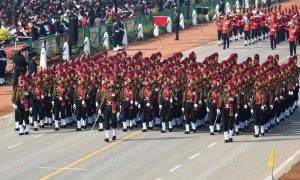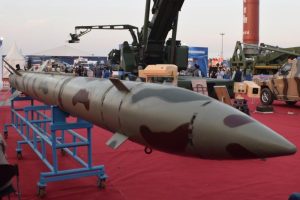 India will take part in the multilateral military “Russian Kavkaz 2020” strategic command-post exercise to be held in Astrakhan, Russia. The Indian contingent includes 150 Army personnel and a smaller number of personnel from the Navy and Air Force. The invitation for participation to Kavkaz 2020, also referred to as Caucasus-2020, has been extended to at least 18 countries including China, Iran, Pakistan and Turkey apart from other Central Asian Republics part of the SCO. India will take part in the multilateral military “Russian Kavkaz 2020” strategic command-post exercise to be held in Astrakhan, Russia. The Indian contingent includes 150 Army personnel and a smaller number of personnel from the Navy and Air Force. The invitation for participation to Kavkaz 2020, also referred to as Caucasus-2020, has been extended to at least 18 countries including China, Iran, Pakistan and Turkey apart from other Central Asian Republics part of the SCO. |
 India will send its Tri-Service contingent to take part in the 75th Victory Day Parade of World War II in Moscow, Russia. India will send its 75-member Tri-Service contingent as the Defence Minister of Russia has invited an Indian contingent to take part in the Victory Day Parade. Contingents of other countries are also expected to participate in the 75th Victory Day Parade of World War II in Moscow. Russia is conducting a military parade on 24th June 2020 in Moscow on the 75th anniversary of the victory in the Second World War. There will be a military parade to honour the heroism and sacrifices made by the Russian as well as other friendly people. India will send its Tri-Service contingent to take part in the 75th Victory Day Parade of World War II in Moscow, Russia. India will send its 75-member Tri-Service contingent as the Defence Minister of Russia has invited an Indian contingent to take part in the Victory Day Parade. Contingents of other countries are also expected to participate in the 75th Victory Day Parade of World War II in Moscow. Russia is conducting a military parade on 24th June 2020 in Moscow on the 75th anniversary of the victory in the Second World War. There will be a military parade to honour the heroism and sacrifices made by the Russian as well as other friendly people. |
 A unit of Indian Army has organized a Self Defence Training demonstration for Women with a theme of “Stronger You Stronger Society”. The Self Defence Training event was organized for the local womenfolk in Nalbari district of Assam. The training demonstration was held with an objective of addressing fear and to empower the girls morally, mentally and physically to defend themselves in any set of circumstances. Ramesh Karki, an international taekwondo player of Indian Army conducted the demonstration along with two local players of International repute. The demonstration also featured the participation of around 250 girl students and staffs from various academic institutions of the Nalbari district. A unit of Indian Army has organized a Self Defence Training demonstration for Women with a theme of “Stronger You Stronger Society”. The Self Defence Training event was organized for the local womenfolk in Nalbari district of Assam. The training demonstration was held with an objective of addressing fear and to empower the girls morally, mentally and physically to defend themselves in any set of circumstances. Ramesh Karki, an international taekwondo player of Indian Army conducted the demonstration along with two local players of International repute. The demonstration also featured the participation of around 250 girl students and staffs from various academic institutions of the Nalbari district. |
 The National Workshop on Explosive Detection (NWED-2020) was held at Pune, Maharashtra. The NWED workshop was organised by High Energy Materials Research Laboratory (HEMRL), Pune. During the workshop, a new explosive detection device known as “RaIDer-X” was also unveiled. The workshop featured the participation of delegates from different DRDO laboratories, Army, CRPF, CISF, State Police, academic Institutes, industries and other security agencies. The National Workshop on Explosive Detection (NWED-2020) was held at Pune, Maharashtra. The NWED workshop was organised by High Energy Materials Research Laboratory (HEMRL), Pune. During the workshop, a new explosive detection device known as “RaIDer-X” was also unveiled. The workshop featured the participation of delegates from different DRDO laboratories, Army, CRPF, CISF, State Police, academic Institutes, industries and other security agencies. |
|
 Defence Minister Rajnath Singh inaugurated the new Light Combat Helicopter (LCH) Production Hangar at Helicopter Division in Hindustan Aeronautics Limited (HAL) Complex at Bengaluru, Karnataka. LCH is a 5.5-tonne class combat helicopter designed and developed by HAL. It is powered by two Shakti engines and inherits many technical features of the Advanced Light Helicopter. LCH has the distinction of being the first attack helicopter to land in forwarding Bases at Siachen, 4,700 mts above sea level with 500kg load. India has made significant progress towards manufacturing military equipment indigenously under the ‘Make in India’ initiative. The defence industry plays a major role in the economic development of the country. Defence Public Sector Undertaking (DPSU) that has helped India leapfrog six places to become the fifth-largest economy in the world. Defence Minister Rajnath Singh inaugurated the new Light Combat Helicopter (LCH) Production Hangar at Helicopter Division in Hindustan Aeronautics Limited (HAL) Complex at Bengaluru, Karnataka. LCH is a 5.5-tonne class combat helicopter designed and developed by HAL. It is powered by two Shakti engines and inherits many technical features of the Advanced Light Helicopter. LCH has the distinction of being the first attack helicopter to land in forwarding Bases at Siachen, 4,700 mts above sea level with 500kg load. India has made significant progress towards manufacturing military equipment indigenously under the ‘Make in India’ initiative. The defence industry plays a major role in the economic development of the country. Defence Public Sector Undertaking (DPSU) that has helped India leapfrog six places to become the fifth-largest economy in the world. |
 Seminar on Indian Defence Equipment was organized in Dhaka by the High Commission of India in Bangladesh. 12 Indian firms participated in the Seminar on Indian Defence Equipment. Objective of the seminar was to pursue further cooperation between India and Bangladesh in the field of defence technologies. The seminar also provided a great opportunity to defence manufacturers from India in building partnerships with Bangladesh. Seminar on Indian Defence Equipment was organized in Dhaka by the High Commission of India in Bangladesh. 12 Indian firms participated in the Seminar on Indian Defence Equipment. Objective of the seminar was to pursue further cooperation between India and Bangladesh in the field of defence technologies. The seminar also provided a great opportunity to defence manufacturers from India in building partnerships with Bangladesh. |
 The Chief of the Defence staff (CDS) General Bipin Rawat has announced the plan of establishing the first Integrated Tri-Services Command. The Integrated Tri-Services Command will be responsible for handing the air defence of the entire country. The command is expected to be established by June 2020. The planned Integrated Tri-Services command will be headed by an Indian Air Force (IAF) officer. The Chief of the Defence staff (CDS) General Bipin Rawat has announced the plan of establishing the first Integrated Tri-Services Command. The Integrated Tri-Services Command will be responsible for handing the air defence of the entire country. The command is expected to be established by June 2020. The planned Integrated Tri-Services command will be headed by an Indian Air Force (IAF) officer. |
|
 On February 11, 2020, United States approved sale of Integrated Air Defence Weapon System to India. The cost of the system is estimated as 1.86 billion USD. On February 11, 2020, United States approved sale of Integrated Air Defence Weapon System to India. The cost of the system is estimated as 1.86 billion USD. |
|
|
|
 Defence Research and Development Organisation (DRDO) has started developing a 200-km strike range tactical ballistic missile ‘Pranash’. The missile is an advanced version of the 150-km strike range Prahar missile which was being developed for tactical missions. The surface-to-surface ballistic missile will be of use for the Air Force and Army. It is a solid-propellant surface to a surface missile which can travel at the speed of Mach 2. Defence Research and Development Organisation (DRDO) has started developing a 200-km strike range tactical ballistic missile ‘Pranash’. The missile is an advanced version of the 150-km strike range Prahar missile which was being developed for tactical missions. The surface-to-surface ballistic missile will be of use for the Air Force and Army. It is a solid-propellant surface to a surface missile which can travel at the speed of Mach 2. |
 The Bhabha Atomic Research Centre developed a new bullet proof jacket called Bhabha Kavach. The jackets are to be used by the Central Industrial Security Force (CISF). The Bhabha Atomic Research Centre developed a new bullet proof jacket called Bhabha Kavach. The jackets are to be used by the Central Industrial Security Force (CISF). |
|
|
You need to login to perform this action.
You will be redirected in
3 sec
